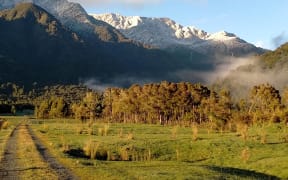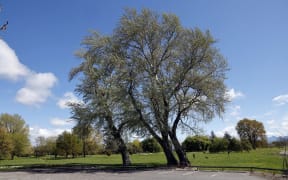By Jared Farmer*, for BBC Future
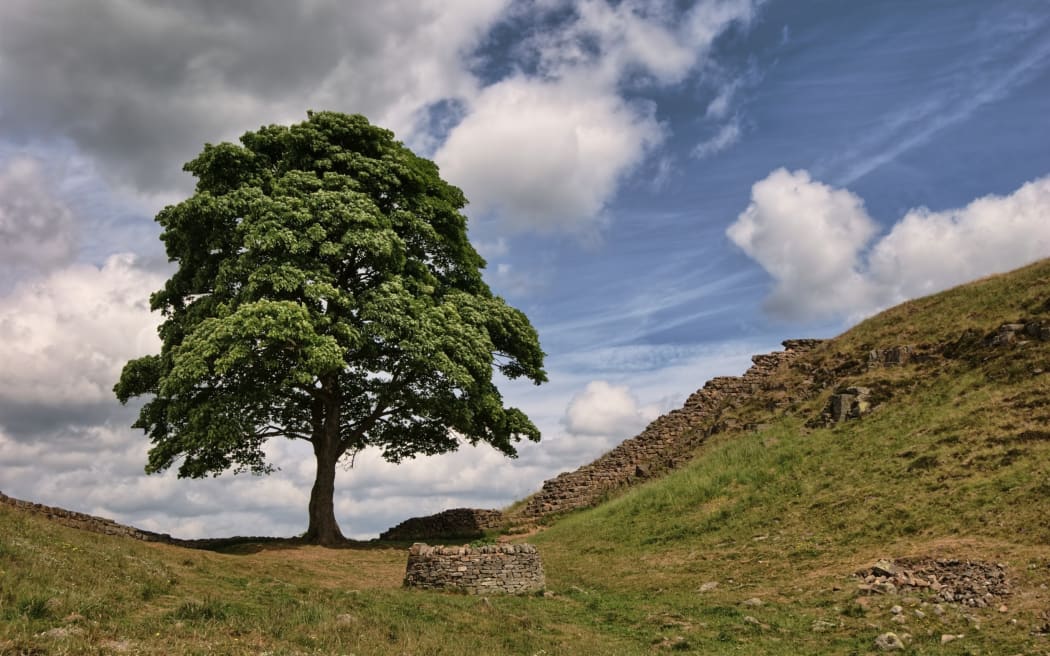
The famous sycamore tree that stood in a gap in Hadrian's Wall in Northumberland, England was around 200 years old when it was chopped down this year. Photo: 123RF
The famed tree of Sycamore Gap in England was cut down after growing there for around 200 years - but this is just rustle of a leaf compared to the lives of some woody plants.
When it comes to trees, there are many ways of being old, and many ways of measuring and valuing oldness.
The sycamore that stood in a gap in Hadrian's Wall in Northumberland, England, was "only" about 200 years old when last month it met a violent end. But the grief about its felling speaks to longer time frames. The architectural location of the "Sycamore Gap tree" gave it resonance with the Roman period, while its cinematic appearance in Robin Hood: Prince of Thieves (1991) lent it associations with the medieval age. Because a "tree" is basically a plant filled with human meaning, any tree can potentially have timefulness beyond its organismal age.
And through the nurturing of offshoots, a tree's effective lifetime can be extended. Some still hope that the Northumbrian landmark will, like a coppiced tree, resprout from the stump. After all, the ficus (fig tree) by the main temple at Bodh Gaya, India, is not any older than the sycamore at Hadrian's Wall, yet its germplasm - the seeds and other living genetic material - goes back many more centuries: the same sacred fig tended at the same holy site.
Of some 140,000 species of woody plants on the planet, only about 25-30 can, without human assistance, produce specimens that reach the age of 1000 years or older. Of those millennials, only about 10 can reach 2000 years. And of those supermortals - all of them conifers - only three can produce trimillennials. Only one (to current knowledge) can produce quadrimillennials.
In the absence of historical documentation, how do scientists measure organismal age? When it comes to the plants we call trees, there are three main techniques. One is exact; another is estimated to a standard margin of error; and one is guesstimated to varying percentages of probability.

A yew growing in a churchyard in the village of Fortingall in Perthshire, Scotland, is thought to be the oldest living tree in the UK. Photo: Wikimedia Commons
The first technique consists of counting growth rings, one by one. This can be done with a stump, though that necessitates a felled tree. Except in exceptional, unethical situations, tree-ring scientists (dendrochronologists) don't kill trees to date them. Instead, they screw in an increment borer and extract a core sample, hoping they have hit the pith. Tree-ring core samples are comparable to ice cores: the layers inside can be used to reconstruct past environmental conditions, which is invaluable for climate research.
Yet, the category "oldest known" is epistemological as well as biological - a subset of the oldest knowable: those non-clonal woody plants with uneroded piths that can be absolutely dated all the way to the early years of growth.
Very few trees meet those requirements. Almost all woody plants hollow out with time. Only the most resinous heartwood in the most antiseptic environments doesn't decay on the scale of centuries.
Tree-ring scientists face other barriers. Some solid growers like giant sequoia are simply too thick for boring to the center. And some ancient trees are considered too sacred by local guardians to permit core sampling.
So, technicians may turn to the second technique: radiocarbon dating. For this to work, it actually helps to have a hollow tree, allowing access to inner wood, assuming some of the oldest material remains. Carbon-14 dating is also a good choice for plants that don't produce annular growth rings, or don't produce wood at all. Although radiocarbon allows reliable estimates of date ranges, it cannot lead to exact dates.
The third technique guesstimates age from morphology - size and shape. In essence, people calculate arboreal age by multiplying the trunk's diameter at breast height by a certain factor.
The formula can be more or less complex, and more or less accurate, depending on level of knowledge about the growth habits of the species in specific habitats, and the availability of correlating tree-ring data.
Humans have a long history of venerating elderflora (old trees) and megaflora (big trees). They have an equally long history of burning and felling them.
European yew, the longest-lived species in Great Britain, frustrated the dating attempts of learned Britons for centuries. Techniques improved greatly in the 1990s, when radiocarbon and tree-ring data permitted refinement of girth-to-age formulas. A recent scientific appraisal puts the majority of churchyard yews - of about 2000 total - under one millennium, with a possible upper limit of two millennia, which is still "ridiculously old," to quote one of the investigators.
Where do the world's oldest trees live out all their days? The yews of the British Isles provide a clue. You commonly see these evergreen landmarks in churchyards, cemeteries, arboreta, and manor gardens; or, you can seek out uncommon populations in isolated wildwoods or cliffy habitats.
Thus, there are two main "placeways" to longevity - you find Old Ones close to people, or isolated from them. Humans have a long history of venerating elderflora (old trees) and megaflora (big trees). They have an equally long history of burning and felling them.
Ancient trees occur in churchyards, shrines, and temple compounds. With the aid of caretakers, cultivated plants - or their scions - can live for centuries at consecrated sites. Sacred trees and sacred groves can be found throughout East Asia, Southeast Asia, South Asia, Iran, Ethiopia, the British Isles, and Mexico. Jaya Sri Maha Bodhi, the ficus at the center of the Buddhist pilgrimage site in Anuradhapura, Sri Lanka, is probably the oldest living cultivated plant in terms of continuance of the same germplasm in the same locale.
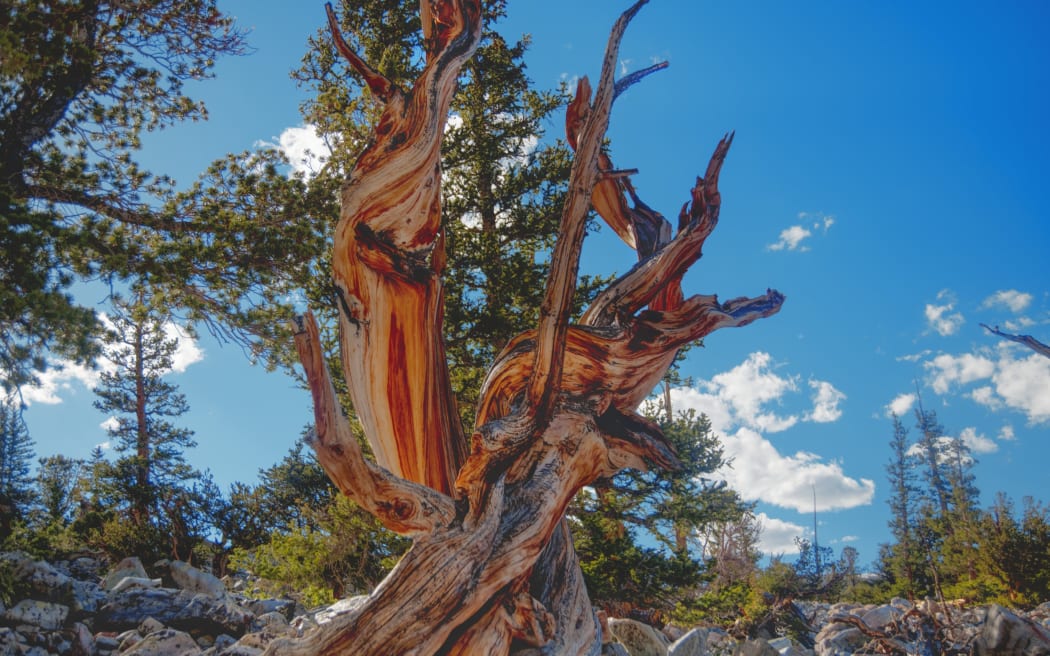
The gnarled, slow-growing Bristlecone pine of the Great Basin are thought to be the oldest living trees on the planet. Photo: 123RF
Inversely, stunted old trees persist in submarginal habitats like New Mexico's El Malpaís (fields of lava), Ontario's Niagara Escarpment (cliffs of dolomite), or New Jersey's Pine Barrens (expanses of sand).
The longest-lived trees of eastern North America, bald cypress, grow in swamps and blackwater rivers. The eldest occur in backwater sections of North Carolina's Black River, just miles from industrial hog farms and fields cleared long ago for tobacco. As only recently discovered, these bald cypresses reach ages of 2600-plus years.
As a rule, gymnosperms (flowerless plants with naked seeds) grow slower and live longer than angiosperms (flowering plants with fruits). For pines, 5000 years is the approximate limit. For oaks, by contrast, 800 years counts as ancient, with outliers reaching over 900 years. Among angiosperms, the age champion is African baobab, capable of ~2500 years - though many of the oldest specimens have toppled in recent years.
Gymnosperms include ginkgo (a genus of one) and every kind of conifer - including yews, pines, firs, spruces, cedars, redwoods, cypresses, podocarps, and araucarias. The cypress family contains the most thousand-year growers.
Conifers achieve maximum longevity when conditions are cold and dry, or hot and dry, or steep and exposed, or high altitude, or nutrient poor. In the case of Great Basin bristlecone pine, the longest-living plant on the planet, it is all of the above, with some of these plants reaching up to 4900 years old. There's an apt maxim developed in the 1950s by tree-ring scientist Edmund Schulman: "longevity under adversity".
Will climate change push these supermortals past their threshold of adversity? Rising temperatures have actually accelerated the growth of upper-elevation bristlecone populations. At the same time, hotter droughts have led to mortalities from bark beetles in lower-level populations, something never observed before.

Baobab trees in Africa are an instantly recognisable part of the Savannah landscape, providing vital shade for the animals that live there. Photo: 123RF
Besides adverse habitat, the strongest correlation with long life is chemical. Longevous conifers produce copious resins - volatile, aromatic hydrocarbons like terpenes - that inhibit fungal rot and insect predation. A high-elevation habitat offers additional protection from enemies, competitors, and fire, provided that trees can tolerate dryness and cold. In habitats with chronic stress, conifers grow slower and stockier. This slow woody growth generates more lignin, an organic polymer that make plants more resilient.
If dwarfism provides one biological pathway to longevity, gigantism provides another. Megaconifers such as alerce in Patagonia, coastal redwood in California, sugi in Japan, and kauri in New Zealand are more likely to survive any discrete attack. In cycles of forest regeneration, they tend to be first and last. They grow quickly as seedlings, establishing soil space, then keep on growing vertically, claiming canopy space. Long life is necessary because opportunities to establish new populations - conditions following intense disturbances - occur infrequently.
The life strategy of largeness comes with one big downside: the risk of falling. Gravity can be as fatal as rot. Another trade-off, the burden of transporting water skyward, explains why the tallest conifers occur in humid temperate zones.
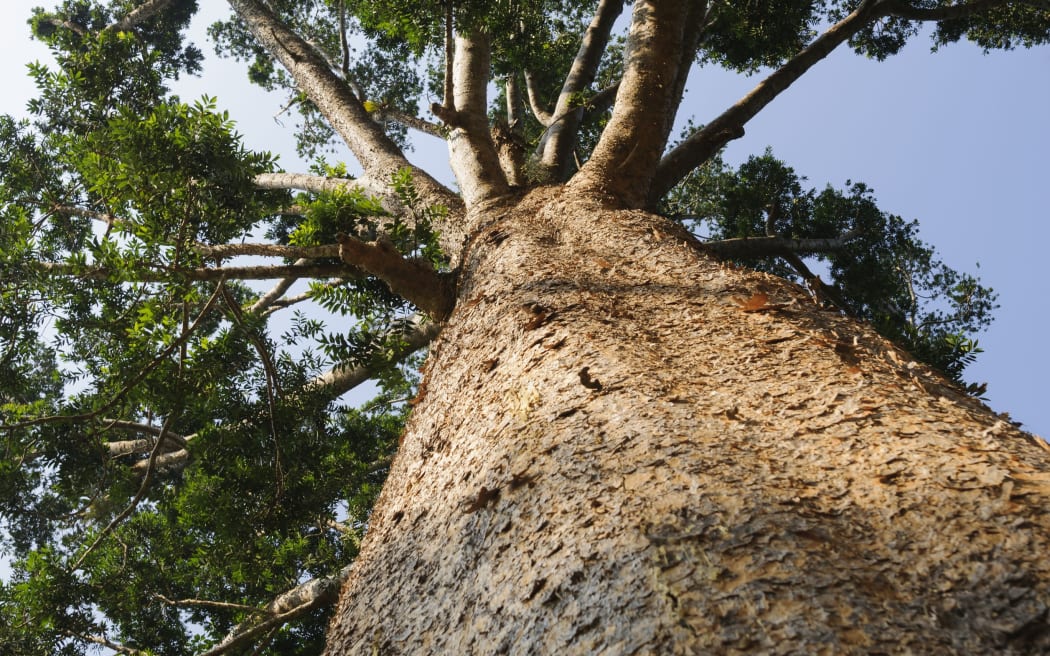
The kauri trees of New Zealand are not only old but also enormous. Photo: 123RF
Where are the best places to look if you want to find an organism that has endured millennia? Western North America, especially California, is a longevity hotspot. So is Tasmania. Huon pine, endemic to Tasmania, is one of very few species known to produce millennial growers at both individual and clonal scales. In addition, its resinous wood is so impervious to rot that multi-millennial trunks in pristine condition have been unearthed.
One thousand years in age is not the only way to measure the venerability of a tree or forest. Besides, not all long-lived organisms are plants. For that matter, not all vegetal forms that have persisted a long time are popularly categorised as "trees" - a term of dignity, not botany. It is time to give shrubby plants and clonal plants greater ethical consideration. As climate change continues, megaflora will become rarer, but organic monuments can and will continue to confer timefulness on landscapes as long as people protect them - and nurture the next offshoots.
* Jared Farmer is the Walter H Annenberg professor of history at the University of Pennsylvania and the author of Elderflora: A Modern History of Ancient Trees, which is available in hardback and will be published in paperback in February 2024. He can be found on social media @geohumanist.
- This story was originally published by the BBC
